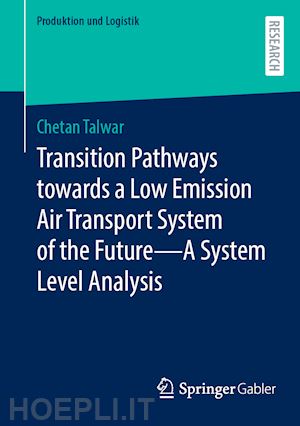
Questo prodotto usufruisce delle SPEDIZIONI GRATIS
selezionando l'opzione Corriere Veloce in fase di ordine.
Pagabile anche con Carta della cultura giovani e del merito, 18App Bonus Cultura e Carta del Docente
The air transport system is a major industry with a global impact of 2.7 trillion dollars. However, the growth of air transport is leading to increasing climate concerns. The main emitters are CO2, NOx and contrails. Regulators have taken initiatives to reduce emissions in line with the 1.5°C target of the Paris Agreement. IATA is aiming for net zero emissions by 2050, with 65% of the emissions reduction to be achieved through SAF and 13% through new technologies. However, there are many uncertainties as to how these targets can be achieved. This book analyses different scenarios and transition pathways to assess the impact of new technologies, policy measures and production delays. Different policies and technologies were tested through a system dynamics model that integrates airlines, demand, fuel producers and regulators. The results show that ambitious targets can only be achieved through a strong combination of measures. While electric and hydrogen aircraft remain challenging in the short-haul segment, SAF can play a key role in the long-haul segment. However, this requires close coordination between all stakeholders.
Introduction.- Air transport framework.- Literature review.- Air transport system model.- Results.- Implication of results and discussions.- Conclusions.- Summary.
Chetan Talwar's research focuses on the comprehensive evaluation of the air transport system. He specializes in analyzing the impacts of new aircraft technologies and policies using system dynamics methodology. His work explores transition pathways involving SAF, electric aircraft and hydrogen propulsion technology to achieve carbon emissions reduction in aviation.











Il sito utilizza cookie ed altri strumenti di tracciamento che raccolgono informazioni dal dispositivo dell’utente. Oltre ai cookie tecnici ed analitici aggregati, strettamente necessari per il funzionamento di questo sito web, previo consenso dell’utente possono essere installati cookie di profilazione e marketing e cookie dei social media. Cliccando su “Accetto tutti i cookie” saranno attivate tutte le categorie di cookie. Per accettare solo deterninate categorie di cookie, cliccare invece su “Impostazioni cookie”. Chiudendo il banner o continuando a navigare saranno installati solo cookie tecnici. Per maggiori dettagli, consultare la Cookie Policy.